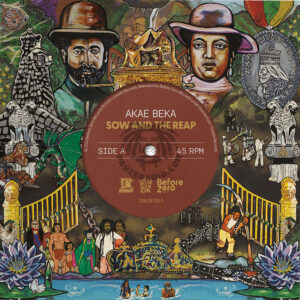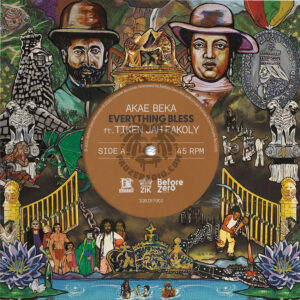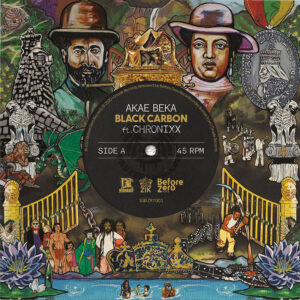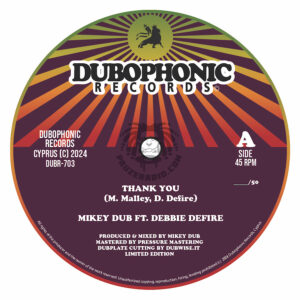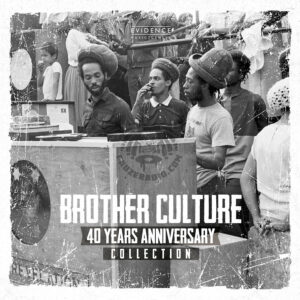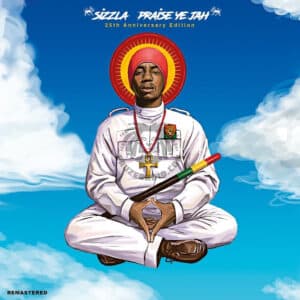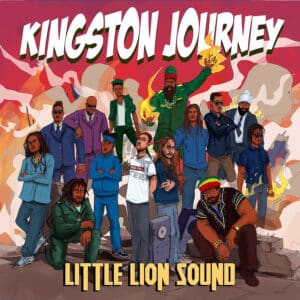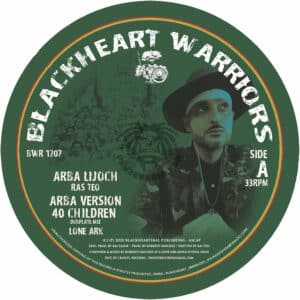
Brown Bones – Brown Bones – Review
Brown Bones: Brown Bones Album Review by Mr Topple for Pauzeradio.com.
The eponymous album from Brown Bones (the pseudonym for Roots musician and producer Andrew ‘Moon’ Bain) is quite the departure for an artist most-known for his complex and highly skilled work in Reggae and Dub. But it’s certainly a welcome one – as the record shows the length and breadth of his talents.
Brown Bones, released via Single Cell Records, is an overly Folk Rock affair. Yes. The Zion I Kings legend has gone Folk Rock. But connoisseurs of ZIK’s sound will realise this is not shock, as such – because the musical skill and diversity present has always been clear. Bones produced the entire album himself; the end result means that Brown Bones is complex, musically detailed and infinitely listenable.
It opens with Arjanine – setting the tone for the project entirely. It’s a rich, intricate Folk Rock/Soul hybrid – led by a gently lilting acoustic guitar, running a delicate refrain comprising arpeggio chords and melodic riffs. But then the track gradually builds, bringing in further elements. The late and sorely missed Andrew “Drew Keys” Stoch’s trombone is almost a nod to Reggae. It comes in next, running a melodic motif similar to that of the main melody’s – at points in unison, at others as a response. The inclusion of a brass instrument with this arrangement in this kind of Folk/Soul music is unusual, but perfectly placed given Bones’s artistic lineage. Then, Arjanine continues to build with Stoch’s keys performing gentle chords marking the start of each bar at first before expanding into a fuller melodic line. Next, and Phillip Peterson’s Soul-led strings become central – at first a cello running a countermelody before violins enter. After this layering is complete, the track suddenly moves up a gear into a momentum-filled bridge with strings dominating the forward motion across staccato crotchets. The track is then stripped back to the acoustic guitar; then building once more but with additional detail. Note the strings glorious tremolo; the bringing in of an electric guitar and Stoch’s melodica. Overall, Arjanine is a beautifully constructed arrangement full of emotive musical peaking and troughing.
Next, and Over the Border builds on this musical landscape. The acoustic guitar is more pointed, here utilising a slap technique which focuses on beat two, to give a rhythmically more driving feel than Arjanine. But instrumentally, the arrangement is generally more stripped back. What is included though is more detail. Strings play a dominant role here, with a complex arrangement that swerves between responses to Bones’s calls, harmonic accompaniment and some effective glissandos. The focus is on the higher kHz with the violin (as opposed to Arjanine’s dominant cello). They’re expertly arranged, serving as a secondary vocal line to bolster Bones’s but also as almost the cries of those of us waiting to be emancipated from the system’s mental slavery. Percussion comes in for the first time in the form of a tambourine striking the downbeats, and chimes bringing atmosphere. All these combined makes Over the Border stripped-back yet haunting simplicity – which is highly compelling.
Vices changes the tone of Brown Bones. Gone is the airy Folk feel – replaced by something brooding and almost gentle Alt/Roots Rock. The stark arrangement focuses heavily on Sara Azrie’s piano line: consisting of mere chords and a treble clef countermelody, it’s set further down its register to create a deeper, unsettling sound. Horns return, running a whining refrain which feels just out of earshot – like the voice of someone in the distance. Strings are back to focusing on the lower kHz, at times performing in unison with the horns. It also sounds like Vices has a melodica line too – which runs a sombre refrain. But an electric guitar is central as well. Here, it breaks out into its own solo bridge just over a third of the way through. Its sound is warm, like the bass and mid on the amp are up slightly. Yet it is Bluesy-Rock in its arrangement – filled with bending, squeaks, reverb and dynamic light and shade. The inclusion of some samples (chinking glasses and a drill press) is utterly superb. And much like Brown Bones’s previous tracks, the genius is in the overall arrangement here – with delicate ebbing and flowing, peaking and troughing and even a brief a cappella moment from Bones. Vices is moving, poignant and wonderfully composed.
Then, Prodigal Stone shifts the album’s tone once more – into something more Soul-led but still with elements of Folk Rock. The opening choral vocals hone in on the Biblical reference in the title, before a slightly raspier (mid/treble amp up) electric guitar runs a solo riff which continues at points throughout. Its acoustic cousin is back, running a chord accompaniment. But there’s also a second electric guitar line (is it a Fender?) which is slightly dampened, tremolo’d and reverbed with heavy bending; all very Surf Rock. A bass appears for the first time, deep and resonant running a smoother, dotted note-led winding riff. A lone tambourine provides percussive interest, as do stark claps concentrating on beat four and what sounds like timpani bringing something slightly thunderous in. But what’s noticeably different on Prodigal Stone to previous tracks is the vocal arrangement. Bones’s backing vocals are prominent: heavily harmonised across the bridges but sparser on the chorus and verses. The result is gently flowing, atmospheric and somewhat ethereal concoction which is as attractive as it is pleasing.
Siren Market is the first overly-forthright nod to Bones’s Reggae credentials – still with Folk Rock at its heart but as a purely instrumental track. You can’t get away from those Reggae/Dancehall sirens and samples, and the Dub engineering across decay and reverb. Claps interestingly often do a four-to-the-floor (a nod to Steppers, perhaps?) while a shaker does a near-skank as the track progresses. But Siren Market’s lilting acoustic and electric guitar lines are the main feature. They wind in and out of each other, running alternate refrains which mingle perfectly like two vocalists. It’s a pleasant, almost interlude-type piece which nicely hat-tips to Bones’s Reggae roots.
Ode to Reprieve is the first track to be in a 3/4 time – cementing the Folk Rock feel of it instantly. Choral vocals return with lilting soprano voices performing a refrain. It’s a grandiose example of the genre. From its slightly stripped back and brief opening verse sequence with the strumming acoustic guitar, it becomes embellished gradually: a bass enters, as does a whining electric guitar. Azrie’s piano is bold, running its own melodic line across a bridge, performing chord-and-melody accompaniment on the verse before upping the style to something quite forte on the chorus. This dynamic emergence is mimicked by the other instruments, with some brief cymbals also entering. Azrie provides some attractive backing vocals here too. But again – what’s so clever about the track is once more the gentle peaking and troughing of the music. This seeming liking for ebb and flow that Bones has is one of the marks of the album. His skill at emotive arrangement is clear – and the light and shade across the instrumentation maintains interests and engages you with the music; Ode to Reprieve being another fine example of this.
I Become Light shifts Brown Bones once more. Here, Rex Howard’s drums are dominant for the first time, giving the track a harder Alt/Roots Rock edge than what’s come before it. From its haunting, ethereal opening the track is in some respect quite morose; led by a minor key. Howard treads a fairly abrasive riff: hi-hats run dotted rhythms switching between open and closed technique; the snare is forceful and the kick rumbling. Keys run a quaver-led riff, driving the track forward. An electric guitar whines just out of earshot; the bass runs with the chord progressions and there are some gently flowing strings at points. But what works so well and movingly here is that this ominous arrangement melts away for the chorus as the track shifts into a major key and the melodic line moves up Bones’s register. The second verse is slightly pared-back on the first with more focus on the guitar lines, before it builds again, then falls and finally makes way for a rousing, affirming finale. Simply glorious.
These Old Ghosts builds on the Alt/Roots Rock feel – creating perhaps the most forthright feel of Brown Bones. The deceptively stripped-back, acoustic guitar and bass-led intro, with Bones performing harmonised vowel sounds, and the following opening verse quickly make way for something extremely punctuated across the chorus: an electric guitar, piano and drums run dotted unison chords, before moving into something that almost feels Ska, with that plink-plonk bubble rhythm on the piano juxtaposed with stomping drums. But again, this washes away for the verse after that – once more cleverly reflecting the lyrical content. There’s some good use of occasional punches from the drums and a scratch sample; the electric guitar that runs a countermelody to Bones’s is particularly pleasing with some use of MTR to build a call and response sequence. Azrie’s backing vocals are on-point – and These Old Ghosts is a smartly constructed affair which takes the album up a dynamic gear, away from the dominant Folk Rock.
Tectonic Plates takes Brown Bones into almost Electronic Rock-meets-Hip Hop territory albeit with that Surf Rock-sounding guitar coming back again on occasion. The use of instrumentation is brilliant here. The almost Synthwave synth horns are stark and unnerving across their melodic line as decay and compression are laced across them, as is the use of scratching and distortion samples. The programmed drums border on the Hip Hop in some respects with the syncopated kick, snarling snare with its buzz rolls and the sometimes semiquaver-led hi-hats. The synth bass is dirty and grimy – distorted in a low register. There’s some distortion permanently placed across Bones’s main vocal, with Azrie returning on backing vocals but with a prominent role here. The arrangement is pure class – quickly building before quickly fading away again and with a stark a cappella section once more. Sultry and sensuous in droves.
Folk Rock returns on Takes One to Know One. Brad Barr’s rapidly running acoustic guitar line creates more liquid motion than on previous tracks, giving the track gentle momentum. This feel is compounded by the use of a shaker and a slightly stuttering drum line – not present consistently, but when it does appear it focuses on dotted note rhythms and a forthright kick which is quite syncopated. The bass weaves in and out, too but with the focus being on slightly drawn out, legato notes mostly on the chorus. There’s a lovely harmonica line which really brings home the feel of Folk Rock and the combination of Bones’s main vocal and Barr’s backing line creates a rich, detailed palette. It’s an effective composition which stays true to the genre – as does Piercing the Veil, with a classic F major root-to-fifth main chord progression. But Bones has switched this up, working into the minor sixth too. There’s a prominent horn line, here – almost a bit Roots – while the drums punctuate the first beat of each bar and the guitar strums to keep time. It almost feels like a country two step – because it has the feeling of being in a 3/4 time with its use of triplets but the rhythmic arrangement tells you its actually in 2/4.
Brown Bones closes with Carbon Berceuse (Morning Song); marking a return to a softer Alt/Roots Rock sound – with a distinctly Gospel/Soul vocal opening. It’s the perfect musical mimesis of its namesake. The piano gently marks each upbeat with shimmering chords at first, while a guitar lilts. Then, the arrangement builds with more instrumentation comes in as the metaphorical sun rises – settling briefly into a driving feel with the drums on a hard beat dominated by the kick and snare, and an electric guitar whining. Carbon Berceuse’s bass is, when present, quite syncopated – while a djembe or similar particularly stands out as it rattles away. There’s a clever use of rapid snaps (is that a bird pecking?) and there’s a wonderful moment where the piano breaks out into impressive demisemiquaver runs – like the sun glistening on the water. It’s a beautifully arranged piece, and its positive feel is the perfect end for the album.
Overall, Brown Bones is musically superb work. Then, you have Bones’s vocal. It’s fascinating as a listener to hear the voice of someone usually behind an instrument or a mixing desk. But it’s also a pleasure to see Bones emerge from these. In some respects, he has a classic Folk Rock voice: generally gentle, with a delicate huskiness that exudes authenticity. His range is solid – working around a mid-to-upper tenor, but being equally comfortable in its lower end as well as across a falsetto. Bones displays good breath control – being able to extend notes well – and his vibrato is expressive and attractive. But it is of course his interpretation which really stands out. He is an accomplished performer. Across all the tracks, you get the feeling that he is delivering the songs either as live, or in some cases (like I Become Light) for the first time. His timbre is compelling; the thoughtful way in which he performs the lyrics compels you to listen and to take notice and his use of dynamics for emotive value is beautiful. Then, Bones has created a lyrical backdrop which is the jewel in Brown Bones’s crown.
When the album is lyrically, performatively and thematically juxtaposed with its musical thrust it almost reminds you of a 21st version of the Counting Crows seminal album August and Everything After – minus some of the slightly abrasive Alt/Roots Rock edge: put Ode to Reprieve next to the Crows’ Raining in Baltimore; I Become Light with Sullivan Street; Vice with Time and Time Again and so on.
So, while the influences of artists like Tracy Chapman and Joan Armatrading are undeniable in the Folk Rock-meets-Soul overtones, the undertones of harder Alt/Roots Rock are also present. Then, when viewed through the prism of its lyrical content, Bones has created something full of thoughtful yet at times unsettling introspection, often sombre in nature and with complex narratives – so, overall – August and Everything After springs to mind.
From Arjanines’ working through extreme trauma, with its ‘lost love’ inflections which borderline on the possibility of someone who took their own life, to Vice’s devastating unpacking of addiction (which Bones’ has masterfully crafted both through the eyes of a loved one but with the insight of an addict). These Old Ghosts is reflective look at the people Bones has lost over the years (tying in to I Become Light). Takes One to Know One delivers a message of solidarity in the face of adversity, while Piercing the Veil has a clever lyrical interplay with its musical origins: ‘don’t dance with the devil’.
Over the Border details the struggle to survive under the system that constantly keeps us chained in mental slavery – but with the possibility of emancipation fully fleshed out. Prodigal Stone shows Bones at his more vulnerable – admitting fallibility in a relationship which he has abused but wishes he hasn’t, even though the other person ‘keeps on coming back’; possibly a metaphor for faltering spiritual faith? And Ode to Reprieve is almost Prodigal Stone’s ‘part two’ – as he lets go of what is already lost because of his actions. Tectonic Plates sees a relationship return, as Bones deals with the initial flush of desire most of us have felt at some point.
But it’s I Become Light which is Bones at his finest. It’s a ballad to the late Stoch, sung in the first person as him – painting a gorgeous, tapestried tribute to the human behind the music and reminding us that while the flesh is down, the creative legacy is always high. It should be noted on this track that the arrangement marries with the lyrics perfectly – the imagined fear, anger and regret Stoch probably felt at the moment of his physical passing during the unsettling minor key verses, before the glorious rising up of his spirit and the knowledge that his creative legacy will live on eternally washes over the major key chorus. It’s a piece of fine musical art, and as a sum of its parts is probably the album’s stand-out track. Utterly moving and compelling which may bring forth unexpected tears.
Brown Bones is undeniably groundbreaking work: one of the most respected musicians and producers in Roots has gone full circle to Folk-come-Alt/Roots Rock; glistening with inflections of Soul and Reggae, too. But Bones has pulled it off with aplomb: immersing himself in the genres and swathing us in them at the same time. Musically accomplished, the album has an expansive yet rich and highly emotive musical tapestry. Bones has proven himself to be a deft performer and lyricist as well, weaving introspective, thought-provoking and moving narratives throughout which he delivers with passion and purpose. Overall, Brown Bones is a debut masterpiece – one that lingers in the memory long after the music has stopped.
Listen to Mr Topple’s radio show here: The Topple UnPauzed Show
Do you need a review or press release. Book our services for your latest release here.
Brown Bones Brown Bones Album Review by Mr Topple / Pauzeradio PR Services (26th August 2021).


